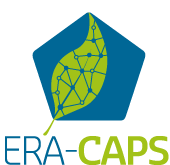Evolution in a changing environment: the genetic architecture of adaptation outside centers of domestication of Phaseolus vulgaris and P. coccineus
- Acronym BEAN_ADAPT
- Duration 36
-
Project leader
Papa, Roberto (PL), Italy, U Politecnica delle Marche
-
Other project participants
Fernie, Alisdair, German, MPI f molekulare Pflanzenphysiologie
Graner, Andreas, Germany, Leibniz I f Pflanzengenetik u Kulturpfl
Gepts, Paul, USA, U of California, Davis (UCD)
Jackson, Scott, USA, U of Georgia
- Funding
- Total Granted budget ca. € 1.636.745
Abstract
|
This project seeks to understand the genetic architecture of adaptation of the common bean (Phaseolus vulgaris; Pv) and its cross-compatible sister species, the runner bean (Phaseolus coccineus; Pc), in their centers of origin in the Americas and following their dispersal to Europe, as a model for future major environmental and socio-economic changes, such as increases in temperature, variability in rainfall, and new consumer preferences. We will identify the genetic basis and phenotypic consequences of adaptation to new environments through the study of their introduction and expansion in Europe, as a historically well-defined event of recent and rapid adaptation. We will use a multidisciplinary approach (genomics, population/ quantitative genetics, biochemistry, plant physiology) on a nested set of samples. A large collection (11,500 accessions, Pv_ALL and Pc_ALL) from three major genebanks, will be characterised by genotyping-by-sequencing (GBS), to define the population structure and to obtain subsets of genotypes for phenotyping (field and growth chamber) and deeper genomic–transcriptomic–metabolomic characterisation. In a subset of 500 geo-referenced lines of Pv (Pv_core1), we will obtain the whole genome sequencing (WGS), which will be used for population genomics by comparing subpopulations from the two continents (defined geographically and genetically). This will identify the effect of selection for adaptation to European environments and for genome-wide association studies (GWAS), which will be based on field trials in four contrasting environments, to focus on phenological adaptation. Both species (Pv_core2, Pc_core1) will also be studied under controlled conditions for plant responses (growth, phenology, transcriptomics, metabolomics) to contrasting conditions of photoperiod and temperature. Differential expression analysis, analysis of the co-expression patterns, and GWAS will be used to identify genes and metabolites putatively associated with adaptation, while genotypic information obtained from RNA-seq data will be used, with GBS and WGS data, to test for signatures of selection. We will compare the results between the allogamous Pc and the two gene pools of autogamous Pv, where shared signatures between species and gene pools (neutrality tests, expression analysis) will provide a powerful cross-validation tool. The integrated datasets will be used to provide candidate genes to be validated using bulk segregant analysis (BSA). Among the main outcomes of BEAN_ADAPT are the development in Pv of haplotypes of all 10,000 accessions (HapBean), along with associated information and seed stocks, which will represent a unique tool for plant scientists. For Pc, we will also have a well-defined set of information that will constitute the foundation for the development and application of its genomic resources. |
